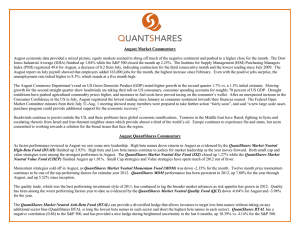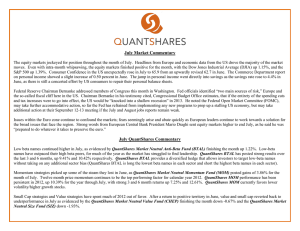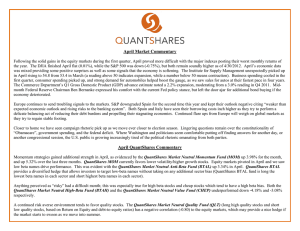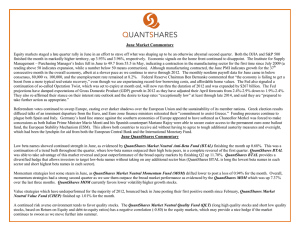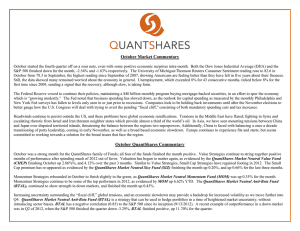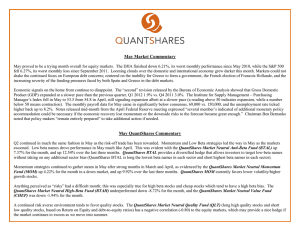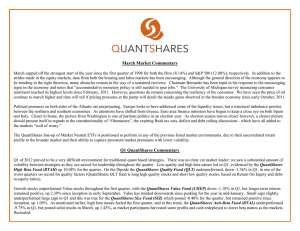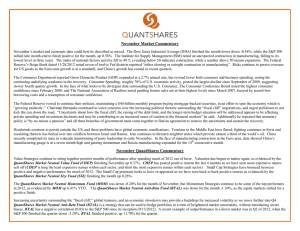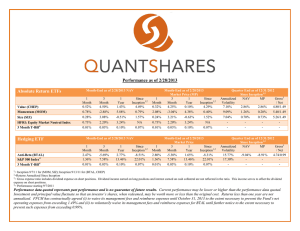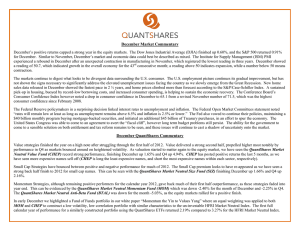February Market Commentary
advertisement
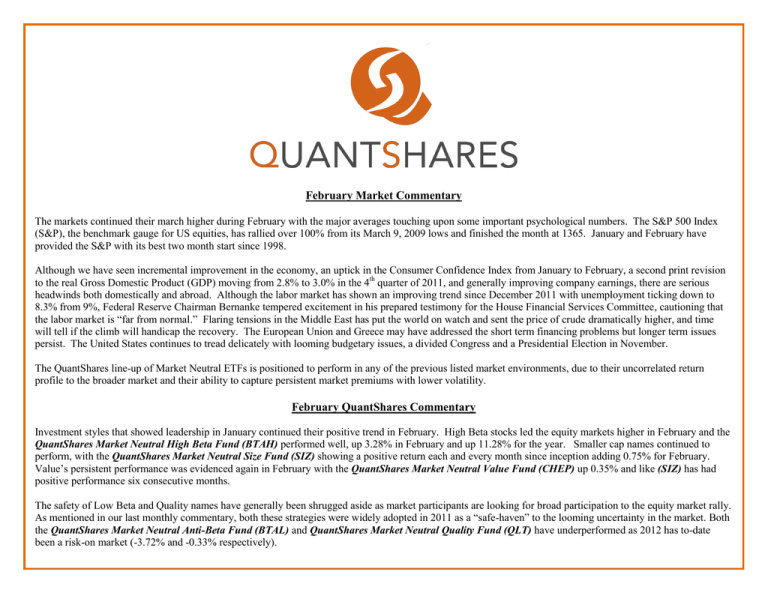
February Market Commentary The markets continued their march higher during February with the major averages touching upon some important psychological numbers. The S&P 500 Index (S&P), the benchmark gauge for US equities, has rallied over 100% from its March 9, 2009 lows and finished the month at 1365. January and February have provided the S&P with its best two month start since 1998. Although we have seen incremental improvement in the economy, an uptick in the Consumer Confidence Index from January to February, a second print revision to the real Gross Domestic Product (GDP) moving from 2.8% to 3.0% in the 4th quarter of 2011, and generally improving company earnings, there are serious headwinds both domestically and abroad. Although the labor market has shown an improving trend since December 2011 with unemployment ticking down to 8.3% from 9%, Federal Reserve Chairman Bernanke tempered excitement in his prepared testimony for the House Financial Services Committee, cautioning that the labor market is “far from normal.” Flaring tensions in the Middle East has put the world on watch and sent the price of crude dramatically higher, and time will tell if the climb will handicap the recovery. The European Union and Greece may have addressed the short term financing problems but longer term issues persist. The United States continues to tread delicately with looming budgetary issues, a divided Congress and a Presidential Election in November. The QuantShares line-up of Market Neutral ETFs is positioned to perform in any of the previous listed market environments, due to their uncorrelated return profile to the broader market and their ability to capture persistent market premiums with lower volatility. February QuantShares Commentary Investment styles that showed leadership in January continued their positive trend in February. High Beta stocks led the equity markets higher in February and the QuantShares Market Neutral High Beta Fund (BTAH) performed well, up 3.28% in February and up 11.28% for the year. Smaller cap names continued to perform, with the QuantShares Market Neutral Size Fund (SIZ) showing a positive return each and every month since inception adding 0.75% for February. Value’s persistent performance was evidenced again in February with the QuantShares Market Neutral Value Fund (CHEP) up 0.35% and like (SIZ) has had positive performance six consecutive months. The safety of Low Beta and Quality names have generally been shrugged aside as market participants are looking for broad participation to the equity market rally. As mentioned in our last monthly commentary, both these strategies were widely adopted in 2011 as a “safe-haven” to the looming uncertainty in the market. Both the QuantShares Market Neutral Anti-Beta Fund (BTAL) and QuantShares Market Neutral Quality Fund (QLT) have underperformed as 2012 has to-date been a risk-on market (-3.72% and -0.33% respectively). Standardized Performance as of 02/29/2012 Strategic ETFs Month-End as of 02/29/2012 NAV 1-Mo 3-Mo Value (CHEP) Quality (QLT) 0.35% -0.33% Size (SIZ) Russell 1000 Index*** 3 Month T-Bill*** Tactical ETFs Month-End as of 02/29/2012 Market Price (MP) 1-Mo 3-Mo 1.87% -3.10% Since Inception* 5.13% -3.52% 0.70% -0.12% 0.75% 1.08% 2.86% 4.39% 0.00% 10.39% 0.00% 18.60% 0.00% 3.42% -1.65% Since Inception* 6.24% -2.32% Annualized Volatility 7.95% 6.84% 3.62% -2.40% 3.66% -2.40% 2.50/.99 2.50/.99 1.87% 1.96% 2.90% 9.02% 1.45% 1.01% 2.97/.99 4.39% 0.00% 10.39% 0.00% 18.60% 0.00% 23.32% - - - - Month-End as of 02/29/2012 NAV 1-Mo 3-Mo High Beta (BTAH) Momentum (MOM) Anti-Beta (BTAL) Anti-Momentum (NOMO) Russell 1000 Index*** 3.28% -0.43% -3.72% -0.16% 4.39% 3 Month T-Bill*** 0.00% Quarter End as of 12/31/2011 Since Inception* NAV MP Month-End as of 02/29/2012 Market Price 1-Mo 3-Mo 7.65% -3.84% -8.30% 2.66% 10.39% Since Inception* 11.40% -4.45% -14.57% 0.98% 18.60% 1.75% -1.67% -3.67% -1.36% 4.39% 0.00% 0.00% 0.00% Quarter End as of 12/31/2011 Since Inception* NAV MP Gross**/Net 6.38% -2.97% -7.86% 1.67% 10.39% Since Inception* 9.91% -3.63% -13.35% 0.94% 18.60% Annualized Volatility 19.92% 9.91% 21.23% 9.33% 23.32% Gross**/Net -0.41% -2.12% -3.98% -0.62% - -0.81% -1.91% -4.23% -0.86% - 3.27/.99 2.79/.99 1.92/.99 2.07/.99 - 0.00% 0.00% - - - - *= Inception 9/7/11 for (MOM, NOMO, QLT, SIZ); Inception 9/13/11 for (BTAH, BTAL, CHEP) **= Gross expense ratio includes dividend expense on short positions. Dividend income earned on long positions and interest earned on cash collateral are not reflected in the ratio. This income serves to offset the dividend expense on short positions. ***= Performance starting 9/7/2011 Performance data quoted represents past performance and is no guarantee of future results. Current performance may be lower or higher than the performance data quoted. Investment and principal value fluctuate so that an investor’s shares, when redeemed, may be worth more or less than the original cost. Returns less than one year are not annualized. Since the Funds are new, the Operating expenses are based on first year anticipated Assets Under Management growth. FFCM has contractually agreed to waive fees and expenses to limit net expenses from exceeding 0.99% until August 31, 2012. Company Overview: QuantShares designs and manages Market Neutral ETFs to provide exposure to well-known equity factors such as Momentum, Value, Quality, Beta and Size. QuantShares Market Neutral ETFs are the first ETFs that have the capability to short physical stocks (as opposed to derivatives) that passively track indexes. Our ETFs offer investors a diversifying asset that is both highly liquid and fully transparent. The ETFs are designed to generate spread returns, diversify risk and reduce volatility. Value, Size and Quality tend to be more strategic in nature and provide strong risk-adjusted returns; Beta and Momentum are more tactical and allows investors to hedge or express short term investment convictions. QuantShares Market Neutral ETFs provide a liquid alternative to help dampen volatility and enhance the risk return profile of an investment portfolio. Disclosures: Before investing you should carefully consider the Fund’s investment objectives, risks, charges, and expenses. This and other information is in the prospectus, a copy of which can be obtained by visiting the Fund’s website at www.quant-shares.com. Please read the prospectus carefully before you invest. Foreside Fund Service, LLC, Distributor. Shares are not individually redeemable and can be redeemed only in Creation Units. The market price of shares can be at, below or above the NAV. Market Price returns are based upon the midpoint of the bid/ask spread at 4:00PM Eastern time (when NAV is normally determined), and do not represent the returns you would receive if you traded shares at other times. Fund returns assume that dividends and capital gains distributions have been reinvested in the Fund at NAV. Some performance results reflect expense subsidies and waivers in effect during certain periods. Absent these waivers, results would have been less favorable. Risks: There is no guarantee that the funds will reach their objective. An investment in the Funds is subject to risk including the possible loss of principal amount invested. See prospectus for specific risks regarding each Fund. There is a risk that during a “bull” market, when most equity securities and long only ETFs are increasing in value, the Funds’ short positions will likely cause the Fund to underperform the overall U.S. equity market and such ETFs. The Funds may not be suitable for all investors. Short selling could cause unlimited losses, derivatives could result in losses beyond the amount invested, and the value of an investment in the Fund may fall sharply. Beta is a measure of an asset’s sensitivity to an underlying index. Long is purchasing a stock with the expectation that it is going to rise in value. Short is selling stock with the expectation of profiting by buying it back later at a lower price. Russell 1000 Index measures the performance of approximately 1000 of the largest companies in the U.S. equity market. One cannot invest directly in an index.
